

Sensory defensiveness. Sensory processing was defined by occupational therapist Anna Jean Ayres in 1972 as "the neurological process that organizes sensation from one's own body and from the environment and makes it possible to use the body effectively within the environment".[4][5] The senses provide information from various modalities, vision, audition, tactile, olfactory, taste, proprioception, vestibular system; in order to adequately function.

The mid-brain and brain stem regions of the central nervous system are early centers in the processing pathway for multisensory integration. These brain regions are involved in processes including coordination, attention, arousal, and autonomic function. After sensory information passes through these centers, it is then routed to brain regions responsible for emotions, memory, and higher level cognitive functions. Classification[edit] Epidemiology[edit] Incidence for the remaining subtypes is currently unknown.
Causes[edit] EEG recording Signs and symptoms[edit] Times: Adults with sensory defensiveness. Impact of, treatment for sensory defensiveness examined in study Most of us use our senses to understand and respond to our surroundings.
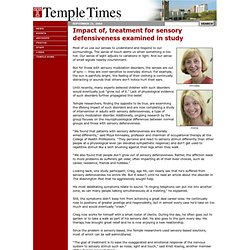
The sense of touch alerts us when something is too hot. Our sense of sight adjusts to variations in light. And our sense of smell signals nearby nourishment. But for those with sensory modulation disorders, the senses are out of sync — they are over-sensitive to everyday stimuli. Until recently, many experts believed children with such disorders would eventually just “grow out of it.” Temple researchers, finding the opposite to be true, are examining the lifelong impact of such disorders and are now completing a study of intervention in adults with sensory defensiveness, a type of sensory modulation disorder.
Wobble Board. The Sensory Connection Program Overview. What Helps?
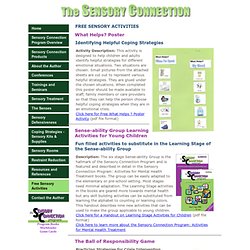
Poster Identifying Helpful Coping Strategies Activity Description: This activity is designed to help children and adults identify helpful strategies for different emotional situations. Two situations are chosen. Small pictures from the attached sheets are cut out to represent various helpful strategies. The Sensory Connection Program Coping Strategies - kits and supp. Sensory Kits for Coping and Calming A Sensory Kit is a collection of items that can be kept handy for the use of patients or staff. Items for the kit are chosen according to the needs of patients or clients in a particular setting. Patients are encouraged to experiment using the various items to determine what they find useful for calming and alerting.
The Kit can be in a basket, box, or suitcase. Adult with Tactile Defensiveness. How can one modify the Wilbarger Protocol so an adult can do this themselves?
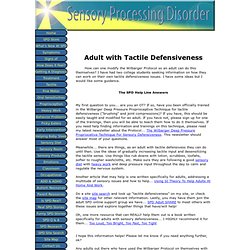
I have had two college students seeking information on how they can work on their own tactile defensiveness issues. I have some ideas but I would like some guidance. The SPD Help Line Answers. Using SI Theory To Help SPD Adul. Welcome to the October 2007 edition of The SPD Companion.

Before I get into this month's newsletter, I would like to tell you about some exciting changes that are happening on the site! If you do indeed get my RSS feed or have read my blog lately, you may have noticed a lot of action going on. I am excited to let you know about some new “interactive” sections on my website. The first is called The SPD Q & A. It is a place where you can ask questions which will then be posted on the site and answered by the the visitors of Sensory-Processing-Disorder.com. Adolescent & Adult SPD Checklist. If you are dealing with Sensory Processing Disorder as an adult, then share your experience, ideas, struggles, questions and solutions you have discovered with the readers of Sensory-Processing-Disorder.com Click below to see contributions from other visitors to this page... 19 and think I have SPD I feel like I really might have this. My friends and family would describe me as over reactive. Noises either go completely unnoticed or sometimes I jump …
Loading... Sensory Processing Disorders: Through The Eyes Of Dysfunction. Have you ever wondered what children or adults with sensory processing disorders feel like, or have to deal with?
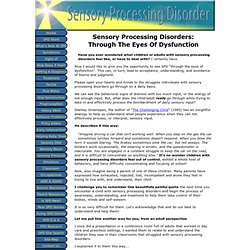
I certainly have. Now I would like to give you the opportunity to see SPD "through the eyes of dysfunction". This can, in turn, lead to acceptance, understanding, and avoidance of blame and judgment. Please open your hearts and minds to the struggles individuals with sensory processing disorders go through on a daily basis. We can see the behavioral signs of distress with too much input, or the energy of not enough input. Stanley Greenspan, the author of "The Challenging Child. Gravitational Insecurity. MH$P: Breyer Collection For Sale-RARE,GLOSSIES,JAH,VINT. DC all housing classifieds "horse" FitBALL® Exercise Ball 55 cm Pearl.
FitBALL® Seating Disc. Sensory Integration & Neuroplasticity. Learning Breakthrough is a pioneering neuro-development tool that combines specially designed balance equipment and carefully selected exercises to improve sensory organization and refine neuro-transmission so that the brain performs better in every environment.
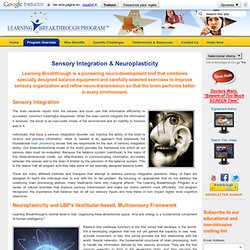
Sensory Integration The brain receives inputs from the senses and must use that information efficiently to accurately construct meaningful responses. When the brain cannot integrate the information it receives, the result is an inaccurate model of the environment and an inability to function well in it. Individuals that have a sensory integration disorder can improve the ability of the brain to receive and process information. What is needed is an approach that addresses the foundational brain processing issues that are responsible for the lack of sensory integration ability. There are many different methods and therapies that attempt to address sensory integration problems. The brain is not a static system. Human Performance Group, LLC. Learning Breakthrough Skip to content Oops, that page is not found, we must have lost our concentration for a second there...

Perhaps you were looking for one of these pages: Translate This Proud Supporter Dr. Dr. Read More Equipment Details. High Startle Reflex Anyone? - ADD Forums - Attention Deficit Hyp. Regardless of ADD - most will jump out of their skin when played 'extreme noise terror' too loud ... unexpectedly ... from right behind ... ... ... but the ADDer often has a much lower threshold ... for 'stomping' Almost as if the perceptual stream has a higher bandwidth in ADDer ... the ADDer is more sensitive ... is taking in more of the spectrum of information which is flowing from without {through our senses} to within ...

A larger volume of data streaming in through our senses would have to be handled. Cramp occurs when the muscle loses its capacity to operate physiologically. High Startle Reflex Anyone? - Page 2 - ADD Forums - Attention De. Quote: I agree in some respects meadd! I have dyslexia and have never had a problem with coordination or long term memory. However, a friend of mine who has ADD is a klutz. He drops and breaks stuff all the time, and seems to regularly injure himself too. As for long term memory, I would say that my ADD not my Dyslexia effects my short term memory more than my long term memory. Retained Reflexes and Vision. What Are Primitive Reflexes?

Many people who have cared for an infant are familiar with primitive reflexes: Turn an infant’s head to one side and the arm and leg on that side turns in the same direction (Asymmetric Tonic Neck Reflex). Stroke an infant’s low back on one side and their side muscles instantly contract (Spinal Galant Reflex). Surprised by a sound, the infant instantly spreads their hands wide, throws their head back, and opens their eyes widely (Moro Reflex). Doctors often gauge the development of the child by the orderly progression of these reflexes. Under optimal circumstances all reflexes “initiate” during the appropriate stage of the child’s development, “integrate” themselves as a fully functioning reflex, and then “inhibit” or fall away when it’s time to move on to the next developmental stage. Autism Information -Primitive Reflexes?
I've seen that webpage before but with different tests. MY computer won't let me view them. Says something about plug-in not working. GMSKids Sensory Motor Integration. The Treatment and Learning Centers - Occupational Therapy.